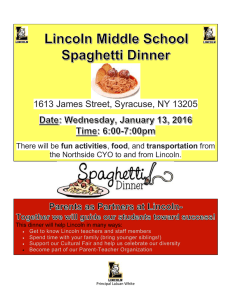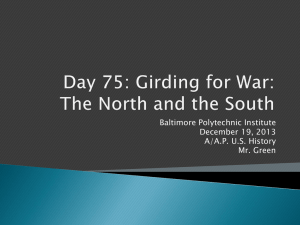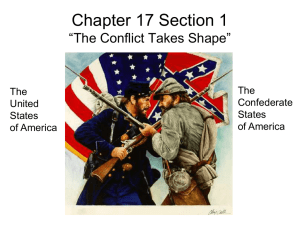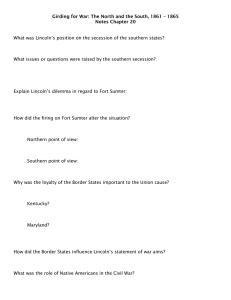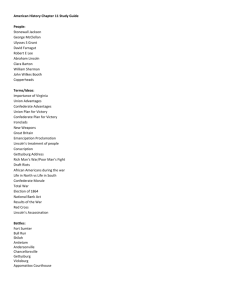North vs. South Unit 7, Lesson 1
advertisement
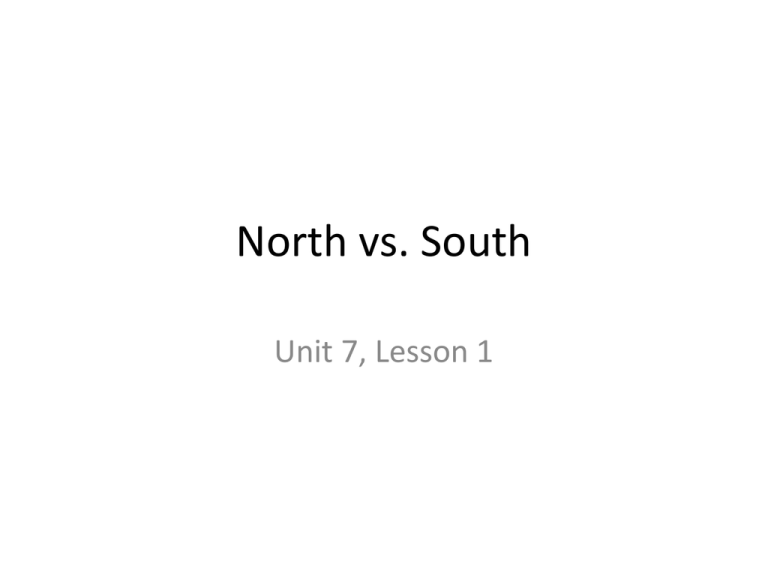
North vs. South Unit 7, Lesson 1 Essential Idea • The North and South both had advantages, disadvantages, political issues, and technology that greatly impacted the Civil War. Purpose of the War • Northern/Union Purpose of the War: • To preserve the Union of states • Southern/Confederate Purpose of the War: • To secede from the Union of states • Southerners could cite compact theory and say the Union had violated their “states’ rights” Northern Advantages • 1. Military—the North had MUCH stronger army and navy • 2. Government—a strong federal government could fund and organize the military • 3. Economy—the North was wealthier and could afford the war • 4. Population—the North had over twice the South’s population • 5. Factories—the North had the most factories, which produced war materials (guns, bullets, etc.) • 6. Infrastructure—more roads/railroads enabled better movement of troops and supplies Southern Advantages 1. Military Leaders—more military colleges and better, smarter generals 2. Stronger Morale—southerners felt they were fighting for their rights and homeland 3. Defensive fight—the South fought defensively, mostly with “home field advantage” (easier to win) Northern Disadvantages 1. Military leaders—overall, Union generals were not as strong 2. Weaker Morale—many northerners did not strongly support the war or think it worth fighting 3. Politics—support for Lincoln weakened over time, and he was in danger of losing reelection Northern Disadvantages • 4. Offensive War—the North had to conquer the South, a HUGE area of land Southern Disadvantages • 1. Military—the South’s military was small and usually outnumbered in battle • 2. Government—a weak federal government struggled to fund and organize the military • 3. Economy—the South was not wealthy and suffered when the North’s navy cut off trade Southern Disadvantages • 4. Population—much smaller, and almost half were slaves • 5. Factories—with few factories, the South struggled to produce war materials • 6. Infrastructure— fewer roads/railroads, hurt movement of troops and supplies • 7. Slaves—it was hard to control slaves and fight the war at the same time Northern Strategy • Northern/Union Strategy: • Anaconda Plan—this would “choke” the South by cutting off trade and resources • Part 1: • Blockade the southern coast • This would cut the South off from supplies from foreign countries • Part 2: • Capture the Mississippi River • This would cut off trade between southern states and divide the Confederacy in half • Purpose of Anaconda Plan • The South would run out of supplies and be forced to surrender A Northern View of Jefferson Davis Southern Strategy • Southern/Confederate Strategy: • The South used a DEFENSIVE strategy, like the United States used against Britain in the Revolutionary War • The South did not have to conquer the North • The South only had to outlast the North until the North got tired of fighting Northern Leaders • Major leaders: • 1. George McClellan—brilliant at building an army, but too cautious in battle • 2. Ulysses S. Grant—won many battles, but sacrificed many men • 3. William T. Sherman— ruthless, introduced “total war” Southern Leaders • Robert E. Lee—best general for either side • Lee was AGAINST secession, but loyal to his home state, Virginia • Thomas “Stonewall” Jackson— known for his bravery Political Problems for Lincoln • 1. Border states • Lincoln’s treatment of Maryland was seen by many as unconstitutional • Lincoln used federal troops to stabilize Kentucky and Missouri since many citizens there wanted to secede Conscription • 2. Conscription (draft) • Congress eventually drafted northern citizens to be Union soldiers • Blacks were excluded and wealthy citizens could buy a substitute for $300 • New York draft riots— largest civilian insurrection in American history • Mainly Irish immigrants fought, angry that they were most likely to be drafted • They also killed blacks because they feared losing jobs to them • New York Draft Riots Political Problems for Lincoln • 3. Northern Morale • Many northerners opposed the war, especially as it dragged on • Copperheads— northern anti-war Democrats • Lincoln was unpopular by the 1864 election • A different president could end the war with Confederate independence and/or the continuation of Political Problem for Lincoln • 4. British-Confederate Alliance • Britain depended on southern cotton • Britain was considering joining the Confederacy against the Union • British manufacturers were giving the Confederacy warships • Lincoln felt the Union could not win if England got involved Impact of Technology • 1. Railroads—transported troops, supplies, and artillery • 2. Telegraph—with this communication, Lincoln could better coordinate the Union war strategy • 3. Ironclads—the South built an iron ship to confront the Union blockade • The Union countered by building their own “ironclad” and the two fought to a stalemate • Future warships would forever be made of metal, not wood • Monitor and Merrimac • 4. Blockade runners—small, fast, quiet southern ships could smuggle goods past the Union blockade Impact of Technology • 5. Bullets—new conical bullets from rifled gun barrels traveled farther, faster, and more accurately than musket balls • 6. Gatlin gun—this hand-cranked machine gun shot much faster than traditional guns • New Technology Impact of (lack of) Technology • • • • 7. Lack of medicine—more people died from disease than any other cause Amputees often died from infection and disease was rampant on battlefields Impact of Technology: Soldiers used old battle tactics (like fighting in formation) despite new, deadlier weapons • New weapons and poor medicine made the war much bloodier than previous wars
